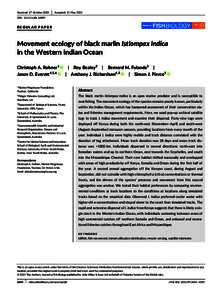Document
Movement ecology of black marlin istiompax indica in the western Indian Ocean.
Identifier
DOI: 10.1111/jfb.14809
Source
Journal of Fish Biology. v. 99, 3, p. 1044-1059
Contributors
Bealey, Roy., Author
Fulanda, Bernerd M. , Author
Everett, Jason D., Author
Richardson, Anthony J. , Author
Pierce, Simon J., Author
Country
United States.
Publisher
John Wiley and Sons Inc.
Gregorian
2021-09-01
Language
English
Subject
English abstract
The black marlin Istiompax indica is an apex marine predator and is susceptible to overfishing. The movement ecology of the species remains poorly known, particularly within the Indian Ocean, which has hampered assessment of their conservation status and fisheries management requirements. Here, we used pop-up archival satellite tags to track I. indica movement and examine their dispersal. Forty-nine tags were deployed off Kenya during both the north-east (November–April) and south-west (August–September) monsoon seasons, providing locations from every month of the year. Individual I. indica were highly mobile and track distance correlated with the duration of tag attachment. Mean track duration was 38 days and mean track distance was >1800 km. Individuals dispersed in several directions: north-east into Somalian waters and up to northern Oman, east towards the Seychelles, and south into the Mozambique Channel. Their core habitat shifted seasonally and overlapped with areas of high productivity off Kenya, Somalia and Oman during the first half of the year. A second annual aggregation off the Kenyan coast, during August and September, did not coincide with high chlorophyll-a (chl-a) concentrations or thermal fronts, and the drivers of the species' presence and movement from this second aggregation was unclear. We tested their habitat preferences by comparing environmental conditions at track locations to the conditions at locations along simulated tracks based on the empirical data. Observed I. indica preferred cooler water with higher chl-a concentrations and stayed closer to the coast than simulated tracks. The rapid and extensive dispersal of I. indica from Kenya suggests that there is likely a single stock in the Western Indian Ocean, with individuals swimming between areas of high commercial catches off northern Somalia and Oman, and artisanal and recreational fisheries catches throughout East Africa and Mozambique.
ISSN
0022-1112
Category
Journal articles

